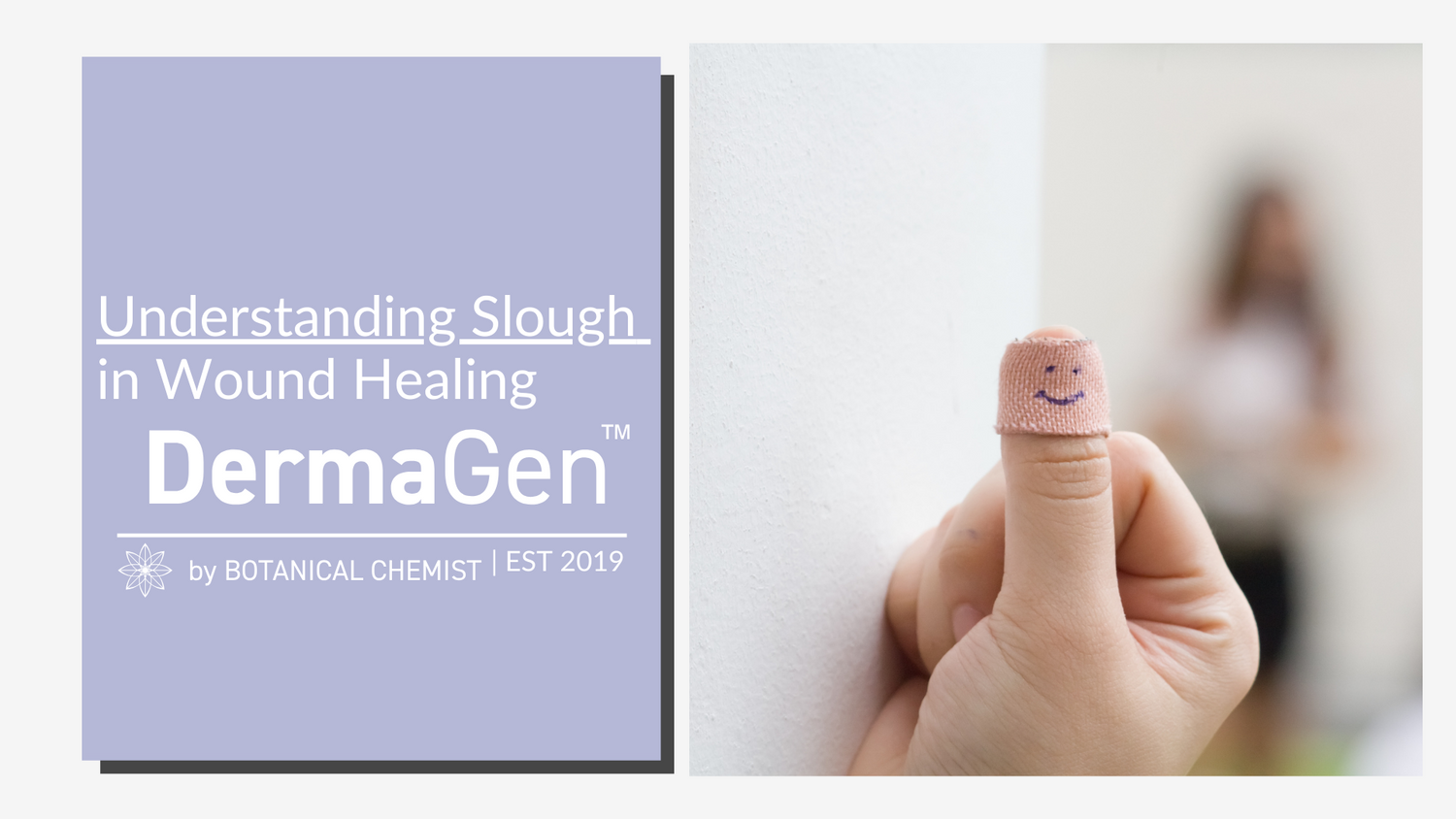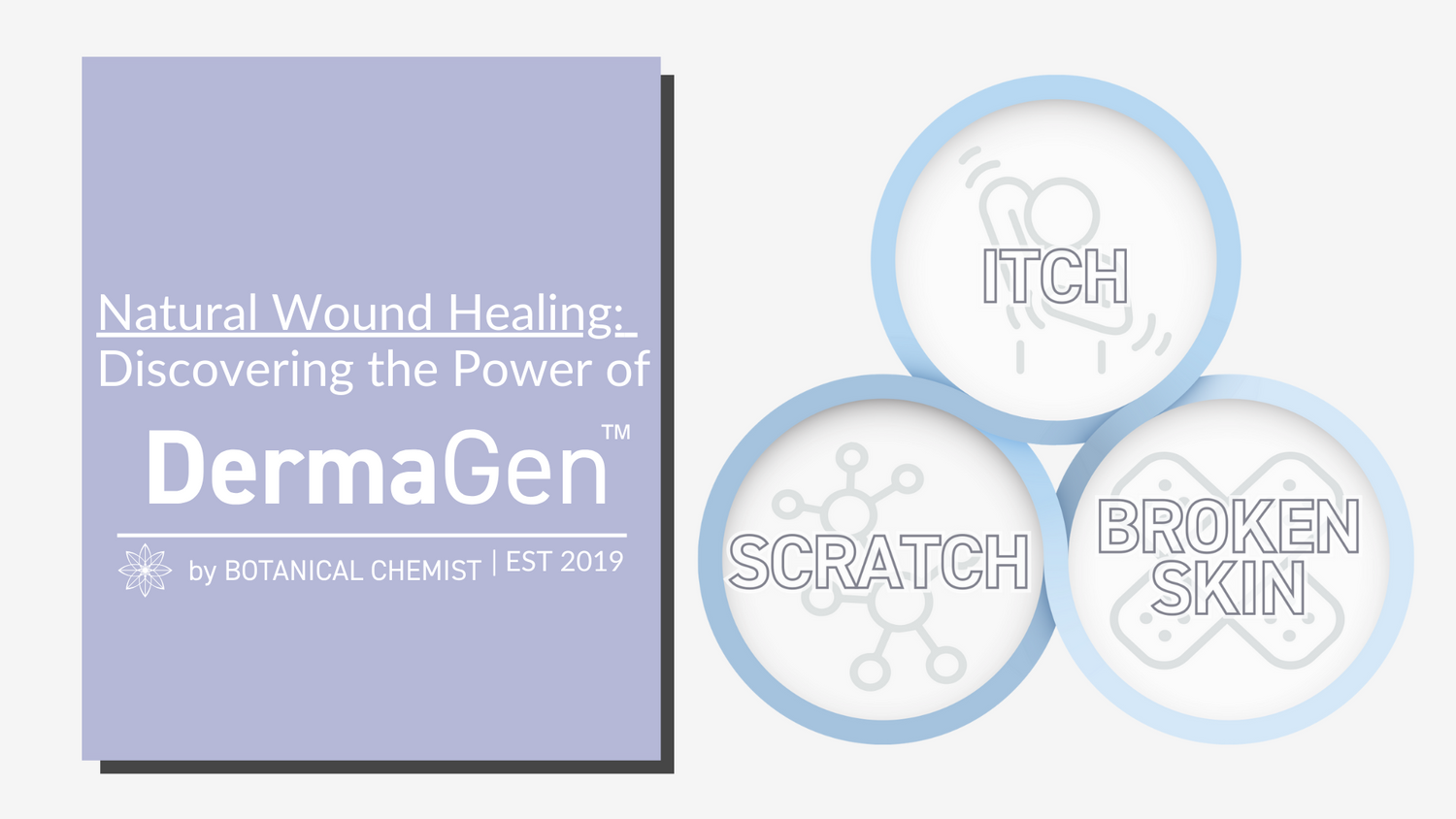Kathryn's journey from injury to recovery serves as a compelling testament to the power of diligent wound care and the effectiveness of natural skincare products.
Her experience began with a fall that not only resulted in a sprained ankle but also left her with a seemingly minor scrape on the other ankle—a minor injury that would soon reveal the complexities of healing.
What followed was a testament to resilience, the efficacy of natural remedies, a newfound appreciation for the body's ability to heal, and a journey into the world of natural healing, guided by DermaGen's innovative skincare solutions.
When she noticed the ignored scrape on the top of her other ankle could be possibly a problem evolving into a larger problem, unable to face yet another trip to the doctors, Kathryn recalled a number of educational pieces she had read from us in the past and started researching.
Understanding the Wound: Infection or Slough?
With the appearance of a yellow crust forming — was this an infection, or was it simply part of the body's natural healing process?

Step 1: Identifying Signs of Infection
When Kathryn embarked on her journey to self-education about wound care, she learned that understanding the signs of infection is crucial for timely and effective intervention. Here are the key indicators she focused on:
1. Increased Redness Around the WoundDetail: Look for redness that expands beyond the immediate area of the wound. This redness often intensifies rather than diminishing over time, signalling that the body is reacting to an infection.
Observation Tip: Compare the wound's surrounding skin colour from one day to the next to monitor changes in redness.

Detail: Swelling is a normal part of the healing process, but when it persists or worsens, it may indicate an infection. The swelling can feel firm and may extend beyond the wound site.
Observation Tip: Note any increase in swelling or if the swelling spreads to adjacent areas, which isn't typical of the normal healing process.
3. Warmth in the Area of the WoundDetail: An infected wound often feels warm or hot to the touch, a result of the body's increased blood flow to the area to fight off infection.
Observation Tip: Gently place the back of your hand near the wound to assess any abnormal warmth, comparing it to the surrounding skin or the corresponding area on the opposite limb.
4. Pus or an Unpleasant OdourDetail: Pus, a thick, often yellowish or greenish liquid, is a common sign of infection. It's composed of dead white blood cells, bacteria, and tissue debris. An offensive odour may also accompany the pus.
Observation Tip: Any new discharge, especially if it's coloured or accompanied by a smell, should prompt further assessment and possibly medical evaluation.
5. Fever or ChillsDetail: Systemic symptoms like fever or chills indicate that the body is mounting a systemic response to an infection, which might have originated from the wound.
Observation Tip: Be vigilant about monitoring your body temperature and note any episodes of chills, as these can be the first signs of a spreading infection requiring medical attention.
Identifying Slough
- Colour: Slough is typically yellowish, white, or even greyish in colour, indicating dead tissue that needs to be removed for healing to proceed.
- Texture: It has a soft, moist, and sometimes stringy texture, unlike the firmer or granular feel of healthy tissue.
- Coverage: Slough may cover parts or the entire wound bed but does not spread beyond the wound like some infections can.
- Odour: While slough can have a mild odour due to dead tissue, it lacks the strong, foul smell often associated with an infected wound.
Differentiating Slough from Infection
- Lack of Spreading Redness: Infection usually causes increasing redness that spreads from the wound edges, which is not characteristic of slough.
- Absence of Excessive Swelling or Heat: Unlike infected wounds, slough does not cause significant swelling or a notable increase in warmth around the wound.
- No Pus Formation: Infections typically produce pus, a thick, coloured discharge, whereas slough is more of a solid material that doesn't have the liquid consistency of pus.
- Stable Pain Levels: While some discomfort may be associated with the healing process, the sharp, increasing pain that often accompanies infection is usually absent with slough.
- Lack of Systemic Symptoms: Infections can lead to systemic symptoms like fever and chills. The presence of slough without these symptoms suggests it's part of the normal healing process rather than an infection.

Step 3: Making an Informed Decision
After comparing her symptoms to the information she gathered, Kathryn decided that while her wound showed redness around the wound with a little swelling it also exhibited slough formation, it was an opportunity to put DermaGen’s balms to the test and see just how well they work.
Step 1: Gentle Cleansing with Natural Liquid Soap and Shampoo
Starting with DermaGen's Natural Liquid Soap and Shampoo, Kathryn ensured her wound was free from harmful bacteria and debris. This pH-balanced, gentle cleanser is crafted with natural ingredients that cleanse without stripping the skin of its protective barrier, making it an ideal first step in wound care. Its formulation respects the skin's natural balance, crucial for maintaining an environment conducive to healing.
Step 2: Dual Healing Approach with Manuka and Propolis Balms

Kathryn's treatment regimen included alternating applications of Manuka Oil Balm and Propolis Balm, both known for their remarkable healing properties.
- Manuka Oil Balm: Leveraging the natural antiseptic and anti-inflammatory properties of Manuka oil, this balm plays a pivotal role in preventing infection while promoting the regeneration of healthy skin. Manuka oil, renowned for its healing capabilities, targets harmful bacteria while nurturing the skin's natural repair mechanisms.
- Propolis Balm: Propolis, a resinous substance collected by bees, is celebrated for its antimicrobial and healing benefits. The Propolis Balm acts as a , while its bioactive compounds stimulate skin renewal and repair. Its application not only accelerated the healing process but also worked to reduce inflammation and soothe the skin.

Step 3: Protecting the Wound
Covering the wound with a Solosite cover followed by a bandage dressing, Kathryn protected her wound from external contaminants and physical irritants. This final step ensured the wound remained in an optimal healing environment, shielded from further injury while allowing the skin to breathe and regenerate under the protection of DermaGen's healing balms.

The Healing Journey
As Kathryn embarked on her path to recovery, her meticulous approach to wound care, blending attentiveness with the nurturing power of natural ingredients, marked a transformative period in her understanding of self-care and resilience.
The Transformation Unfolds
With each day, Kathryn witnessed the gradual transformation of her wound. The once concerning area began to show signs of improvement, diminishing in both size and severity.
A significant milestone was reached when, during a routine cleaning, the slough that had once blanketed the wound gently detached, revealing the new, healthy skin underneath.
This moment was not just a physical turning point but a poignant reminder of the body's innate capacity for healing, especially when supported by the right care.

The Power of Natural Ingredients
Kathryn's routine, anchored in the use of DermaGen's Natural Liquid Soap and Shampoo for cleansing and the alternating application of Manuka Oil Balm and Propolis Balm, showcased the profound impact of selecting products that work in harmony with the body's natural processes.
The antiseptic and anti-inflammatory properties of Manuka oil, combined with the antimicrobial and healing benefits of propolis, offered a dual-action approach that not only combated potential infection but also nurtured the skin back to health.
A Testament to Proactive Care
Kathryn's journey underscores the importance of being proactive and informed in managing one's health. Despite her initial reluctance to seek further medical advice, her openness to doing so if necessary highlighted a balanced approach to natural healing.
Her success in navigating the healing process at home not only alleviated the strain on healthcare resources but also reinforced the value of attentive wound management and the effectiveness of DermaGen's product ingredients.

Conclusion: A Reminder of Nature's Healing Potential
Kathryn's story serves as a powerful testament to the importance of comprehensive wound care and the remarkable potential of natural skincare products in supporting the body's healing journey.
It reminds us of the critical need to pay attention to all injuries, regardless of their initial appearance, and the advantages of choosing skincare solutions that align with our body's natural healing mechanisms. Through her experience, we are reminded of the resilience of the human body and the efficacy of embracing nature's path to recovery.







